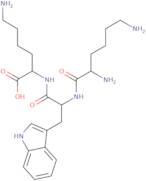H-Lys-Trp-Lys-OH acetate
CAS: 38579-27-0
Ref. 3D-NBA57927
| 25mg | Discontinued | ||
| 50mg | Discontinued | ||
| 100mg | Discontinued | ||
| 250mg | Discontinued | ||
| 500mg | Discontinued |
Product Information
- <span class="text-smallcaps">L</smallcap>-Lysine, <smallcap>L</smallcap>-lysyl-<smallcap>L</span>-tryptophyl-
- <span class="text-smallcaps">L</smallcap>-Lysine, N<sup>2</sup>-(N-<smallcap>L</smallcap>-lysyl-<smallcap>L</span>-tryptophyl)-
- <span class="text-smallcaps">L</smallcap>-Lysine-<smallcap>L</smallcap>-tryptophan-<smallcap>L</span>-lysine
- <span class="text-smallcaps">L</smallcap>-Lysyl-<smallcap>L</smallcap>-tryptophanyl-<smallcap>L</span>-lysine
- <span class="text-smallcaps">L</smallcap>-Lysyl-<smallcap>L</smallcap>-tryptophyl-<smallcap>L</span>-lysine
- H-Lys-Trp-Lys-OH
- L-lysyl-L-tryptophyl-L-lysine
- Lysyltryptophyllysine
- Lysyltryptophyllysine Acetate
- L-Lysyl-L-tryptophanyl-L-lysine
- See more synonyms
- L-Lysine, L-lysyl-L-tryptophyl-
- L-Lysine, N2-(N-L-lysyl-L-tryptophyl)-
H-Lys-Trp-Lys-OH acetate is a constant, UV-irradiated molecule that can be used in the study of DNA repair mechanisms. H-Lys-Trp-Lys-OH acetate is composed of three tryptophan residues and two lysine residues, and has been shown to interact with single stranded DNA. The fluorescence of H-Lys-Trp-Lys-OH acetate can be detected by tryptophan fluorescence. It has been found that guanine can also bind to H-Lys-Trp-Lys-OH acetate, which would result in a decrease in the fluorescence intensity.





